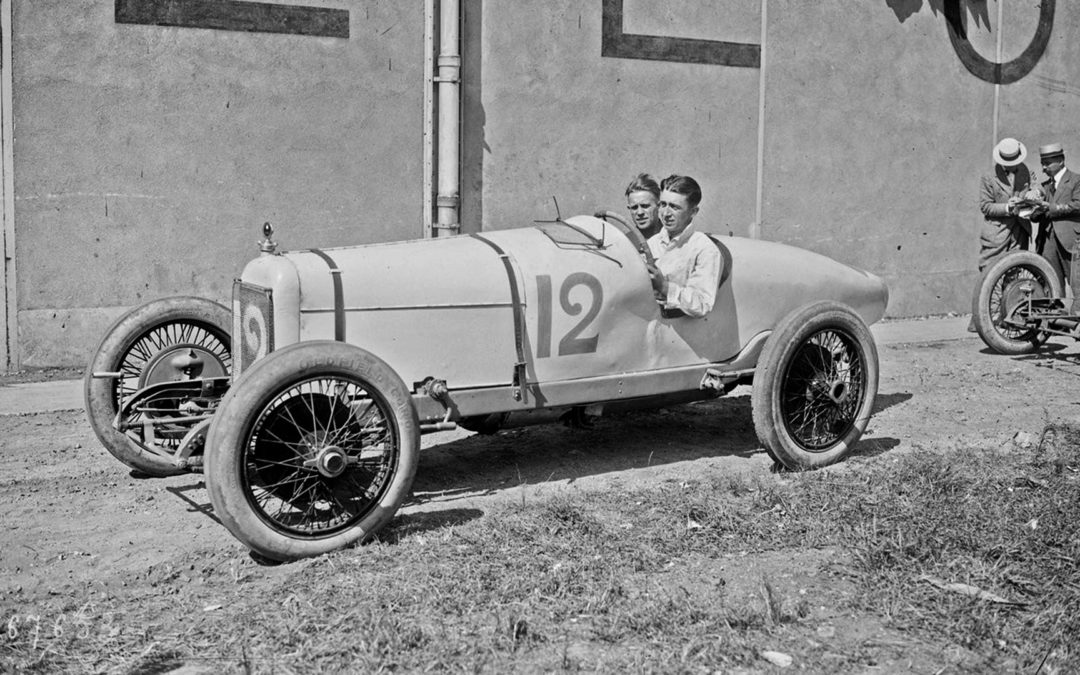
America’s history makers in the French GP paddock [NLF].
Since then, and thanks to a change of servers at IMS, all of those stories disappeared, so on the 100th anniversary of Murphy’s French GP victory, here’s the piece with photos from IMS that ran in 2016, and some new gems made available by the National Library of France:

Jimmy Murphy and Ernie Olson at Le Mans in 1921 [NLF].
But it wasn’t the first time Murphy made international headlines with the pearl white machine.
Step back to July 25, 1921, where the No. 12, fitted with a straight-8 engine designed by company co-founder Fred Duesenberg, made Murphy the first American to win a European grand prix.
Before his Duesenberg-Miller conquered the Brickyard, the original Duesenberg-Duesenberg made stars of Murphy and his auto manufacturer at Le Mans. Among the hundreds of famous racecars and drivers that emerged from the Twenties, few combined to reach the heights achieved by the American auto manufacturer and driver.

Miller and the Duesy firing by on the front straight at Le Mans [NLF].
“During practice for the Grand Prix, [Murphy] had an accident due to brake imbalance with the Duesy’s new four-wheel hydraulic brakes,” Tom Ceretto wrote in Indy Car & Championship Racing magazine. “Bloodied, taped up and in pain with two broken ribs, Jimmy had to be hoisted into his white number 12 Duesenberg at the start of the race.”

His face covered in dirt and grime, a relieved Murphy contemplates his achievement in France [NLF].
At Le Mans, with riding mechanic Ernie Olson at his side, he quickly made his way to the front and weathered intense pain to reach the checkered flag a full 15 minutes ahead of the rest of the field. Born to Irish immigrants and raised without the benefit of wealth, Murphy’s life prior to motor racing was shaped by his rugged upbringing. He was the perfect driver to deal with adversity on the road to triumph in France.
The fame and acclaim that followed from the win made the Duesenberg brand – the renowned “Duesy” – a household name. For Murphy, the transformation from a riding mechanic at Indy to a factory Duesenberg driver to the become first American to vanquish the best (Formula One’s precursor) had to offer was the ultimate rags-to-riches story.

Murphy and Olson at the 1922 Indy 500 [IMS].

A terrible crash on a dirt track in Syracuse, New York ended Murphy’s life on September 15, 1924, three days after his 30th birthday. Adding to his 1922 Indy 500 win and AAA Drivers’ championship, Murphy was posthumously crowned the 1924 AAA champ. In five Indy 500 starts during an era where poor mechanical reliability was the norm, Murphy placed an astonishing fourth, 14th, first, third, and third.
Next time you’re at the IMS Museum, stop by spend some time with Murphy’s old No. 12. As far as racing heroes go, Jimmy and that Duesy might be among the lesser-known legends after 100 years have passed, but they definitely belong among the American greats.

2008 Indy 500 winner Scott Dixon spends some time appreciating the Duesy-Miller [Marshall Pruett].
